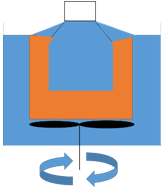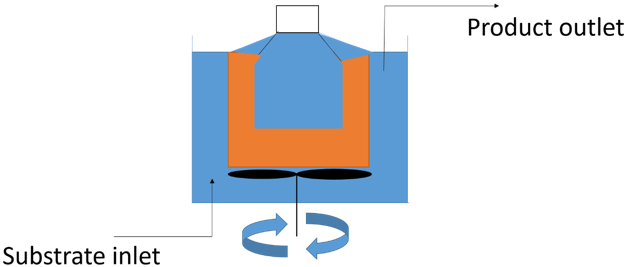This set of Basic Enzyme Technology Questions and Answers focuses on “Immobilized Enzymes – Enzyme Reactors – 2”.
1. Which of the following factor does not determine the choice of the reactor for a particular process?
a) Cost of a predetermined productivity within the product’s specifications
b) Form of enzyme (free or immobilized)
c) Active site is mainly constituted by non-polar amino acids for catalysis to take place
d) Kinetics of the reaction
View Answer
Explanation: Following are the factors which determine the choice of the reactor for a particular process:
* Cost of a predetermined productivity within the product’s specifications.
* Form of enzyme (free or immobilized).
* Kinetics of the reaction.
* The chemical and physical properties of an immobilization support.
Active site is mainly constituted by non-polar amino acids for catalysis to take place. This is one of the features of the active site.
2. _______________ are the reactors containing a settled bed of immobilised enzyme particles.
a) Continuous Stirred tank batch reactors
b) Packed bed reactor
c) Stirred tank batch reactors
d) Fluidized bed reactors
View Answer
Explanation: Packed bed reactor is one in which the reactor contains a settled bed of immobilised enzyme particles. This is also called as plug-flow reactor. Stirred tank batch reactors are those in which all of the product is removed after fixed time. Whereas continuous version of this is referred to as continuous Stirred tank batch reactors. The reactor where in the flow of gas and/or substrate keeps the immobilised enzyme particles in a fluidized state is referred to as fluidized bed reactor.
3. Which kind of reactor is represented in the following diagram?

a) Fluidized bed reactor
b) Packed bed reactor
c) Continuous flow membrane reactor
d) Batch membrane reactor
View Answer
Explanation: The reactor presented in the diagram is batch membrane reactor. This kind of reactor has membrane tubes with an enzyme in it, which allows the substrate to diffuse in and the product to diffuse out. This reactor can be used in a semi-continuous manner which allows to use the same enzyme solution for several batches. This reactor also has heating/cooling coils and baffles in order to increase the stirring efficiency.
4. What does the diagram below represent?

a) Batch membrane reactor
b) Continuous flow membrane reactor
c) Packed bed reactor
d) Fluidized bed reactor
View Answer
Explanation: In this diagram, there is a batch membrane reactor with continuous inflow and outflow of substrate and product respectively. These reactors contain heating or cooling oils to maintain the temperature within the reactor as enzymes are temperature sensitive. It also contains baffles in order to increase or decrease stirring efficiency.
5. The ratio of time that would be required to convert all the substrate if the enzyme acted at Vmax throughout to that of the actual time for complete conversion is referred to as ___________
a) fractional conversion
b) normalized time
c) specificity constant
d) miachelis Menten constant
View Answer
Explanation: The normalized time is relative to the time that would be required to convert all the substrate if the enzyme acted at Vmax throughout, the actual time for complete conversion. The equation is given by \(t_n=\frac{t V_{max}}{[S]_0} \).
Fractional conversion is given by X = 1 – S/S0.
Specificity constant is given by Kcat/Km.
Miachelis Menten constant Km is the substrate concentration at which Vmax is reduced to half.
6. The number which relates to inertial force due to flow of solution to the viscous force resisting that flow is referred to as _____________
a) specificity constant
b) turnover number
c) reynolds number
d) miachelis Menten constant
View Answer
Explanation: The number which relates to inertial force due to flow of solution to the viscous force resisting that flow is referred to as reynolds number. Specificity constant is given by Kcat/Km. Miachelis Menten constant Km is the substrate concentration at which Vmax is reduced to half. Turnover number represents the maximum number of substrate molecules that the enzyme can ‘turn over’ to product in a set time.
7. Le Goff number (Lf) is used in describing and comparing continuous enzyme reactors.
a) True
b) False
View Answer
Explanation: Le Goff number (Lf) is a dimensionless number that expresses the efficiency with which the energy dissipated in producing the fluid flow is used to transport material (and heat) to the catalytic surface. Higher Lf is indicates low pressure drops through the reactor, high flow rates and high conversions. Whereas low Lf value indicate a relatively high energetic and financial cost, in achieving contact between the catalytically active immobilised-enzyme surface and the substrate stream, and the consequent reduction in any external diffusion limitations. Hence the above statement is true.
8. Fluidized bed reactors allow scaling up.
a) True
b) False
View Answer
Explanation: Fluidized bed reactors are those wherein the flow and gas/substrate keeps the immobilised enzyme particles in a fluidized state. FBRs are usually tapered outwards at the exit to allow for a wide range of flow rates. Very high flow rates are avoided as they cause channeling and catalyst loss. The major disadvantage of development of FBR process is the difficulty in scaling-up these reactors. PBRs allow scale-up factors of greater than 50000 but, because of the markedly different fluidization characteristics of different sized reactors, FBRs can only be scaled-up by a factor of 10 – 100 each time. Hence the above statement is false.
Sanfoundry Global Education & Learning Series – Enzyme Technology.
To practice basic questions and answers on all areas of Enzyme Technology, here is complete set of 1000+ Multiple Choice Questions and Answers.
If you find a mistake in question / option / answer, kindly take a screenshot and email to [email protected]
- Practice Chemical Engineering MCQs
- Apply for Biotechnology Internship
- Apply for Chemical Engineering Internship
- Check Chemical Engineering Books
- Practice Biotechnology MCQs
